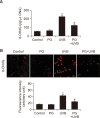Phloroglucinol Attenuates Ultraviolet B-Induced 8-Oxoguanine Formation in Human HaCaT Keratinocytes through Akt and Erk-Mediated Nrf2/Ogg1 Signaling Pathways
- PMID: 32587122
- PMCID: PMC7771840
- DOI: 10.4062/biomolther.2020.059
Phloroglucinol Attenuates Ultraviolet B-Induced 8-Oxoguanine Formation in Human HaCaT Keratinocytes through Akt and Erk-Mediated Nrf2/Ogg1 Signaling Pathways
Abstract
Ultraviolet B (UVB) radiation causes DNA base modifications. One of these changes leads to the generation of 8-oxoguanine (8- oxoG) due to oxidative stress. In human skin, this modification may induce sunburn, inflammation, and aging and may ultimately result in cancer. We investigated whether phloroglucinol (1,3,5-trihydroxybenzene), by enhancing the expression and activity of 8-oxoG DNA glycosylase 1 (Ogg1), had an effect on the capacity of UVB-exposed human HaCaT keratinocytes to repair oxidative DNA damage. Here, the effects of phloroglucinol were investigated using a luciferase activity assay, reverse transcription-polymerase chain reactions, western blot analysis, and a chromatin immunoprecipitation assay. Phloroglucinol restored Ogg1 activity and decreased the formation of 8-oxoG in UVB-exposed cells. Moreover, phloroglucinol increased Ogg1 transcription and protein expression, counteracting the UVB-induced reduction in Ogg1 levels. Phloroglucinol also enhanced the nuclear translocation of nuclear factor erythroid 2-related factor 2 (Nrf2) as well as Nrf2 binding to an antioxidant response element located in the Ogg1 gene promoter. UVB exposure inhibited the phosphorylation of protein kinase B (PKB or Akt) and extracellular signal-regulated kinase (Erk), two major enzymes involved in cell protection against oxidative stress, regulating the activity of Nrf2. Akt and Erk phosphorylation was restored by phloroglucinol in the UVB-exposed keratinocytes. These results indicated that phloroglucinol attenuated UVB-induced 8-oxoG formation in keratinocytes via an Akt/Erk-dependent, Nrf2/Ogg1-mediated signaling pathway.
Keywords: 8-oxoguanine DNA glycosylase 1; Extracellular signal-regulated kinase; NF-E2-related factor 2; Phloroglucinol; Protein kinase B; Ultraviolet B.
Conflict of interest statement
The authors declare that there are no conflicts of interest.
Figures







Similar articles
-
Triphlorethol-A from Ecklonia cava up-regulates the oxidant sensitive 8-oxoguanine DNA glycosylase 1.Mar Drugs. 2014 Oct 28;12(11):5357-71. doi: 10.3390/md12115357. Mar Drugs. 2014. PMID: 25353254 Free PMC article.
-
Silver nanoparticles down-regulate Nrf2-mediated 8-oxoguanine DNA glycosylase 1 through inactivation of extracellular regulated kinase and protein kinase B in human Chang liver cells.Toxicol Lett. 2011 Nov 30;207(2):143-8. doi: 10.1016/j.toxlet.2011.09.002. Epub 2011 Sep 8. Toxicol Lett. 2011. PMID: 21925250
-
Phloroglucinol inhibits ultraviolet B radiation-induced oxidative stress in the mouse skin.Int J Radiat Biol. 2014 Oct;90(10):928-35. doi: 10.3109/09553002.2014.911990. Epub 2014 Jun 6. Int J Radiat Biol. 2014. PMID: 24716481
-
7,8-Dihydroxyflavone suppresses oxidative stress-induced base modification in DNA via induction of the repair enzyme 8-oxoguanine DNA glycosylase-1.Biomed Res Int. 2013;2013:863720. doi: 10.1155/2013/863720. Epub 2013 Sep 14. Biomed Res Int. 2013. PMID: 24151624 Free PMC article.
-
7,8-Dihydroxyflavone protects human keratinocytes against oxidative stress-induced cell damage via the ERK and PI3K/Akt-mediated Nrf2/HO-1 signaling pathways.Int J Mol Med. 2014 Apr;33(4):964-70. doi: 10.3892/ijmm.2014.1643. Epub 2014 Feb 4. Int J Mol Med. 2014. PMID: 24503931
Cited by
-
Myconoside and Calceolarioside E Restrain UV-Induced Skin Photoaging by Activating NRF2-Mediated Defense Mechanisms.Int J Mol Sci. 2024 Feb 19;25(4):2441. doi: 10.3390/ijms25042441. Int J Mol Sci. 2024. PMID: 38397118 Free PMC article.
-
5-aminolevulinic acid photodynamic therapy protects against UVB-induced skin photoaging: A DNA-repairing mechanism involving the BER signalling pathway.J Cell Mol Med. 2024 Jul;28(14):e18536. doi: 10.1111/jcmm.18536. J Cell Mol Med. 2024. PMID: 39044341 Free PMC article.
-
Geniposidic Acid from Eucommia ulmoides Oliver Staminate Flower Tea Mitigates Cellular Oxidative Stress via Activating AKT/NRF2 Signaling.Molecules. 2022 Dec 5;27(23):8568. doi: 10.3390/molecules27238568. Molecules. 2022. PMID: 36500666 Free PMC article.
-
Natural Nrf2 Modulators for Skin Protection.Antioxidants (Basel). 2020 Sep 1;9(9):812. doi: 10.3390/antiox9090812. Antioxidants (Basel). 2020. PMID: 32882952 Free PMC article. Review.
-
Phloroglucinol Enhances Anagen Signaling and Alleviates H2O2-Induced Oxidative Stress in Human Dermal Papilla Cells.J Microbiol Biotechnol. 2024 Apr 28;34(4):812-827. doi: 10.4014/jmb.2311.11047. Epub 2024 Mar 8. J Microbiol Biotechnol. 2024. PMID: 38480001 Free PMC article.
References
LinkOut - more resources
Full Text Sources
Other Literature Sources
Research Materials
Miscellaneous

